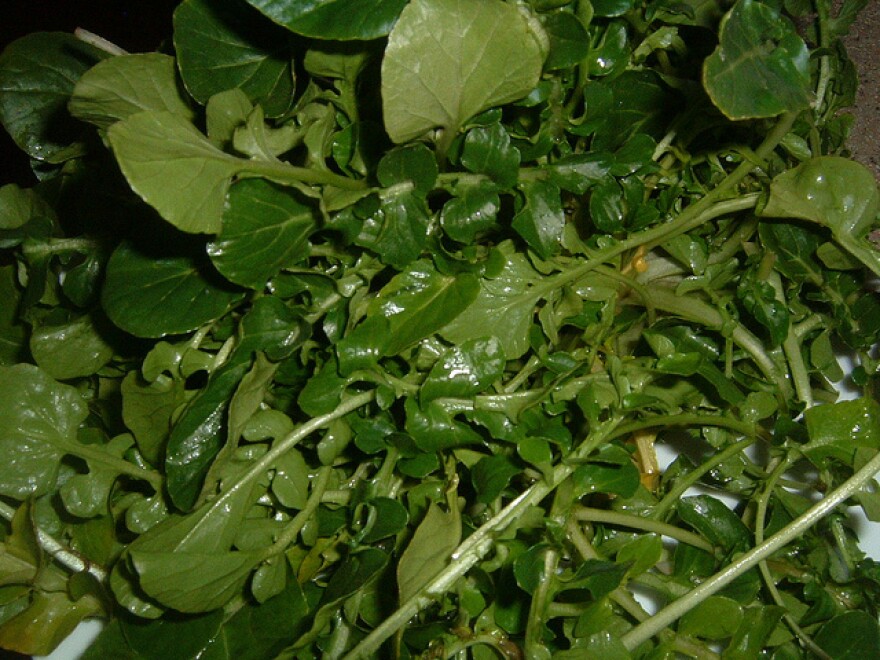When the whole Eat Local movement got started in the Bay Area of San Francisco, foraging in the wild for healthy edible food became a signature activity. Alice Waters of Chez Panisse in Berkeley would dispatch dozens of volunteers to head out into the wilds and bring back baskets of amazing ingredients. And as Chef Jerry Pellegrino points out, those of us living in "the other Bay Area" can do the same.
In fact, Chef Chris Amendola has opened Foraged, described as a "hyper-seasonal eatery" in Hampden. He prowls through to fields and forests of Maryland and southern Pennsylvania, casting a knowledgeable eye over the terrain. The resulting dishes are often small plates, which encourages more browsing, more taste sensations.
Early spring is a good time to find ramps in the woods. These savory members of the onion family have become very chic in recent years. Here's a recipe.
Ramp Pesto
3 garlic cloves, roughly chopped
¼ cup toasted pine nuts or chopped walnuts, pecans or almonds
3 tablespoons grated cheese, such as pecorino
2 cups ramp or other wild onion leaves, about 2 dozen
Salt to taste
About 1/2 cup extra-virgin olive oil
If you are blanching your ramps (which is only necessary if you’re not planning on using the pesto right away to preserve that bright green color) bring a large pot of water to a boil. Add enough salt to make it taste like the sea. Set a large bowl of ice water nearby. Plunge the ramp leaves into the boiling water for 1 minute. Remove and quickly cool them down in the ice water. Squeeze dry with a tea cloth or paper towels.
Chop the ramp leaves and set aside. Pesto is best made with a mortar and pestle, thus the name, which means "pound." You can of course make this in a food processor, but it will not be the same. To start, add the toasted pine nuts and garlic and crush them.
Add the cheese and ramps and commence pounding. Mash everything together, stirring with the pestle and mashing well so it is all fairly uniform.
Start adding olive oil. How much? Depends on how you are using your pesto. If you are making a spread, maybe ¼ cup. If a pasta sauce, double that. Either way, you add 1 tablespoon at a time, pounding and stirring to incorporate it. When it's a nice rough paste, taste it and add salt if you need to; sometimes the cheese makes the pesto salty enough by itself. Serve as a spread on bread, as an additive to soups, as a pasta sauce or as a dollop on fish or poultry.
One of the most spicy peppery flavors around is watercress. This aquatic or semi-aquatic plant is a vigorous grower, and is not hard to find near small streams. In foraging, make sure that the water has not be contaminated with manure, which will pass on toxic bacteria to the plant. Useful in salads and dainty sandwiches, watercress in particularly popular in Great Britain. Here's an idea from Jerry.
Watercress and Pink Grapefruit Salad
for the salad
2 red or pink grapefruits
1 bunch of watercress (about 2 handfuls)
1 small head red Belgian endive
2 large handfuls of baby spinach
½ small red onion, very thinly sliced
1 handful fresh basil leaves, torn or left whole if they are small
dressing
1 cup fresh pink grapefruit juice (from the grapefruits, above)
½ tsp hot chili pepper flakes
4 Tbsp olive oil
1 tsp honey
juice of ½ a lemon
a pinch of salt
Cut off one end of the grapefruits and run a small serrated knife along the rind to remove it. Cut in between each of the membranes to remove the segments of fruit. Set the fruit in a colander to drain over a plate. Squeeze the remains of each grapefruit to get all of the juice out of it. Gather any juice that has drained from the segments, and put it all together in a small saucepan. There should be about a cup.
Add the chili pepper to the juice and boil the juice down until it is a thick syrup. This shouldn't take too long, maybe 15 minutes or so.
When it is thick, combine it with the rest of the dressing ingredients in a small jar and give it a vigorous shaking until it has emulsified. Allow to cool.
Meanwhile assemble the salad ingredients in a large bowl, drizzle the dressing over it, toss lightly, and serve.





